Everything You Need to Know About Diving with Bull Sharks
Table of Contents
- 1 Everything You Need to Know About Diving with Bull Sharks
- 1.1 Understanding Bull Sharks
- 1.2 More Facts about Bull Sharks
- 1.3 Bull Sharks and Human Interaction
- 1.4 Diving with Bull Sharks
- 1.5 Shark Point: Playa del Carmen’s Premier Bull Shark Dive Site
- 1.6 Safety and Requirements for Divers
- 1.7 Rules and Regulations Governing Bull Shark Tours
- 1.8 Choosing a Responsible Dive Operator
- 1.9 The Future of Bull Shark Diving in Playa del Carmen
- 1.10 6 Ways Divers Can Help Protect Bull Sharks and Ensure Their Return to the Riviera Maya
- 1.11 Sources:
Bull shark season on the Riviera Maya has arrived and divers are getting ready to welcome these remarkable marine predators to the warm waters of the Mexican Caribbean.
Each year, from November to March, these powerful sharks gather in the shallow waters off of Playa del Carmen, offering unique and thrilling encounters for experienced divers.
Read on for essential information about the bull shark species, the best ways to dive with them, safety protocols, and the rules governing these exciting excursions.
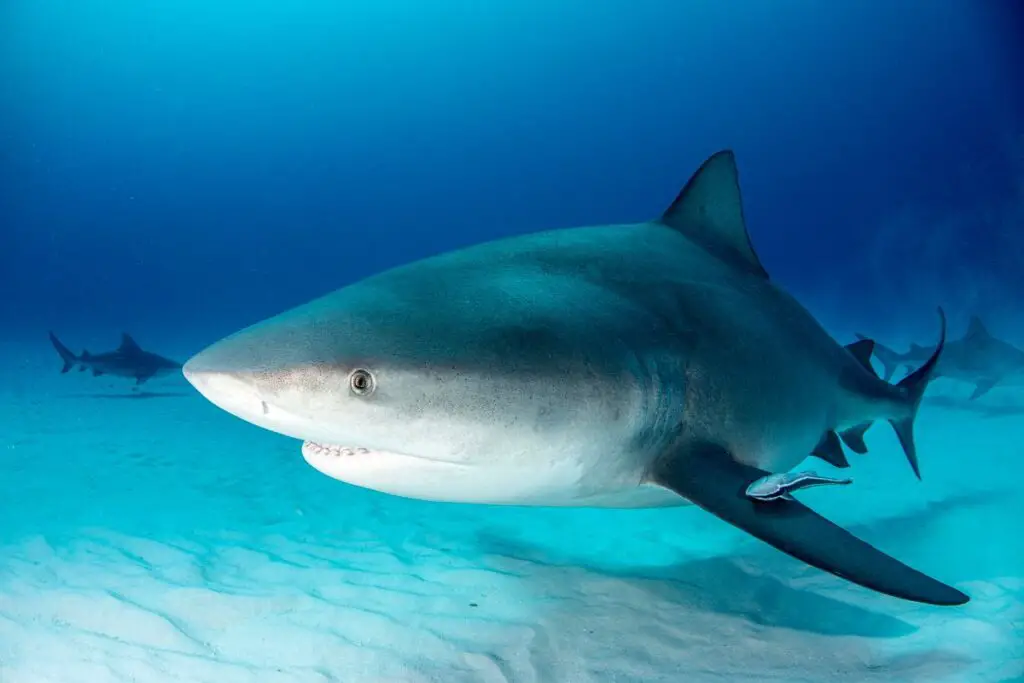
Understanding Bull Sharks
Bull sharks (Carcharhinus leucas) are medium to large-sized sharks known for their robust, muscular bodies and distinct short, blunt snouts. They typically range from 7 to 11.5 feet (2.1–3.5 meters) in length and can weigh between 200 and 500 pounds (91–227 kg). Female bull sharks are generally larger than their male counterparts.
The common name, Bull Shark, is derived from their appearance and their reputation for aggressive, unpredictable behavior, distinguishing them from other sharks such as the tiger shark. Their coloring—a gray top and white underside—helps them blend in with their surroundings, providing natural camouflage.
Bull sharks have a unique adaptability that allows them to thrive in both salt and freshwater, a trait not common among shark species. They are typically found in depths of less than 100 feet (30 meters) and are known to enter estuaries, bays, harbors, lagoons, and river mouths.
Bull sharks can live in freshwater because they are able to regulate the salt levels in their bodies. This adaptability allows them to travel far upriver and even inhabit lakes, making them one of the most versatile shark species.
Bull sharks are known for their bold and sometimes territorial nature, often hunting in shallow waters close to shore. This behavior often brings them near human activities, making encounters more likely compared to other shark species.
Their diet is varied—they are opportunistic feeders and eat fish, dolphins, turtles, birds, and even other sharks. Their dietary flexibility, combined with their wide range, contributes to their survival success.
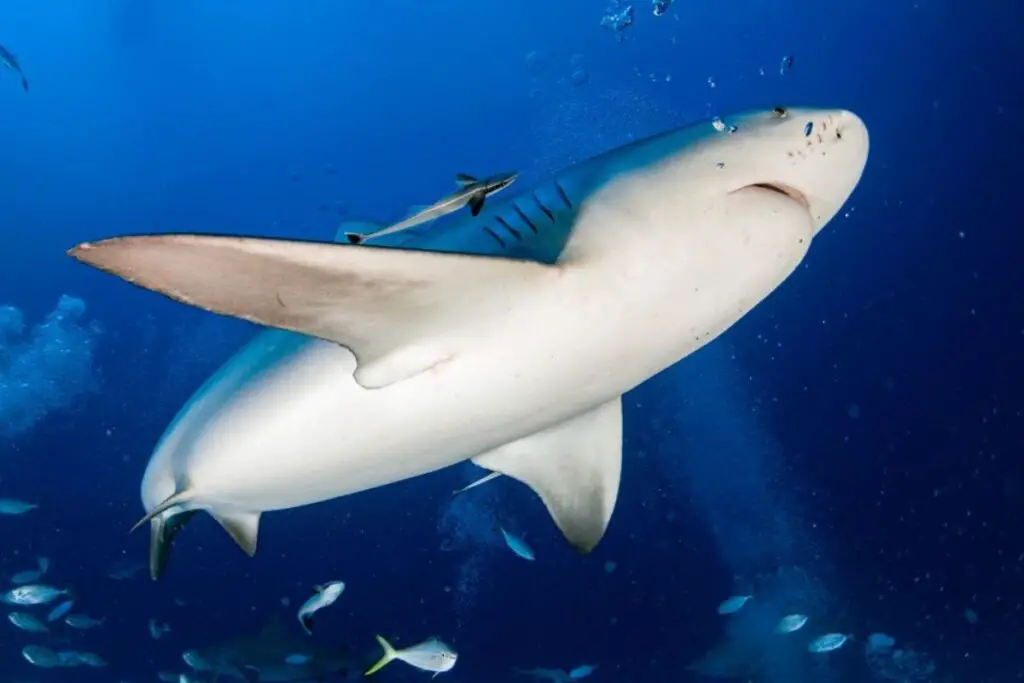
More Facts about Bull Sharks
- Bull sharks have an average lifespan of 16 years in the wild but can live up to 30 years or more.
- Bull sharks are generally solitary creatures and primarily hunt alone.
- Sharks have electroreceptors that run from the brain throughout their body in a lateral line. This serves to capture vibrations over great distances. They can sense when a fish is injured or compromised in some way, making them a fierce predator.
- Although bull sharks have poor vision, they can feel movements and light even at night.
- Their hearing is sharp. They can perceive low-frequency sounds and even determine which direction the sound is coming from.
- The bull shark’s sense of smell is keen. They can smell the presence of small quantities of flesh or blood in the water and even determine its origin.
- The bull shark’s sense of touch comes from bumping into objects with its nose to determine whether the object is edible or not.
- Bull sharks give birth to live young, a method known as viviparous reproduction. After a gestation period of 10 to 11 months, females seek shallow waters, like those near Playa del Carmen, to give birth.
- These nursery areas provide safety for the young sharks, protecting them from larger predators until they are ready to venture into deeper waters.
- The bull sharks can give birth to 1 to 13 live pups.
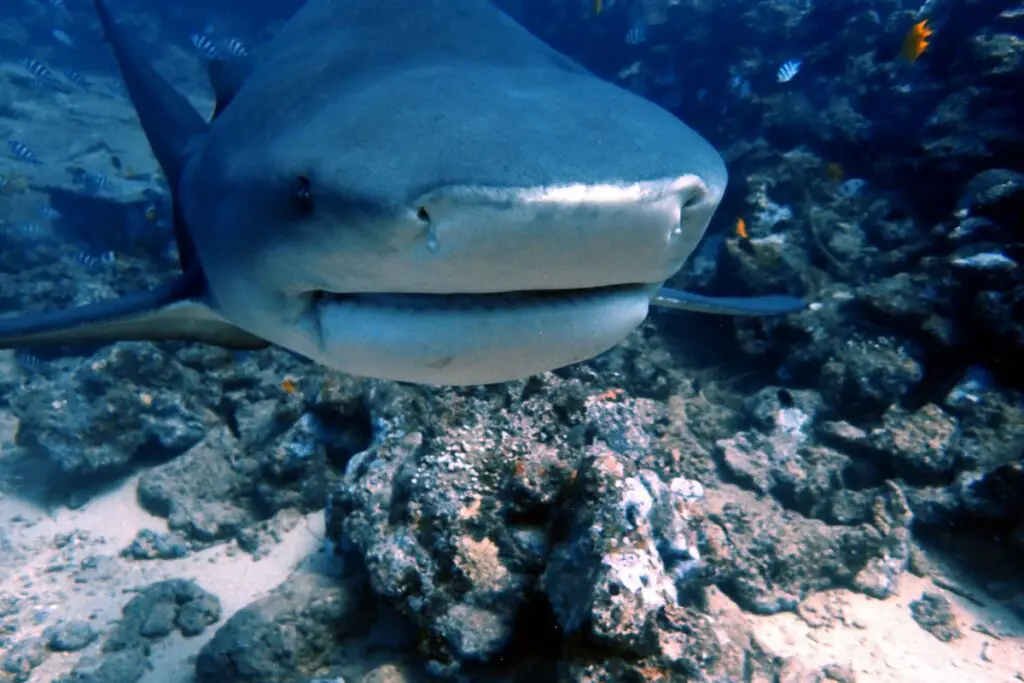
Bull Sharks and Human Interaction
Bull sharks have a reputation for being one of the more aggressive shark species, largely because they frequent areas where humans swim and fish. However, their presence in shallow waters is not due to a desire to encounter humans but rather because these environments support the food sources they rely on.
When diving with them in controlled settings, divers witness firsthand that these sharks generally prefer to mind their own business.
Diving with Bull Sharks
The bull sharks’ seasonal gathering in Playa del Carmen offers a rare and awe-inspiring opportunity to see them in their natural habitat. Dive experiences are organized to prioritize both safety and respect for the sharks.
Dive tours are typically conducted at a dive site called Shark Point, a sandy-bottomed area around 25 meters (82 feet) deep. Here, divers can observe bull sharks up close, often seeing several sharks swimming together. Divers generally stay close to the seabed and minimize movement, allowing sharks to approach on their own terms.
Book your Bull Shark Dive with ScubaCaribe
Book your Bull Shark Excursion with DiversLand Mexico
Shark Point: Playa del Carmen’s Premier Bull Shark Dive Site
Located just off the coast of Playa del Carmen, Shark Point is a quick 5-minute boat ride from shore. This dive site is characterized by its sandy bottom and excellent visibility, which makes it ideal for observing bull sharks.
The depth of Shark Point, around 25 meters (82 feet), allows for a stationary dive experience where divers can watch the sharks without disturbing them. Bull sharks tend to swim close to the sand, making this environment perfect for close yet safe observation.
Marine Life at Shark Point
During bull shark season, the sharks you will encounter at Shark Point are primarily pregnant females. These sharks are sometimes accompanied by remoras and triggerfish, adding to the diverse marine scene. The dive site offers a clear, unhurried view of these animals as they cruise along the sandy bottom, creating a calm yet thrilling experience.

Safety and Requirements for Divers
Diving at Shark Point requires an Advanced Open Water certification due to the depth and specific conditions of the site. Divers are also advised to have recent diving experience and excellent buoyancy control.
Bull shark diving requires calm, deliberate movements and full wetsuits to minimize any risk of accidental contact with the sharks or other marine life.
Rules and Regulations Governing Bull Shark Tours
Due to the depth and nature of bull shark dives, most operators require an Advanced Open Water certification or an equivalent. This requirement ensures that divers are well-prepared for the depth and potential currents encountered at Shark Point. In addition to certification, divers need good buoyancy control and experience with deep diving.
Bull shark dives require full-length wetsuits to protect divers against the cold and to minimize exposed skin, as bright or contrasting colors can attract sharks. Divers are advised to use dark-colored gear, avoiding anything flashy or brightly colored, as this reduces the likelihood of attracting the sharks’ attention.
When diving with bull sharks, divers are usually instructed to remain stationary, either by holding onto a line or settling on the sandy bottom. This minimizes disturbances to the sharks and allows divers to enjoy a safe, up-close experience. Sudden movements are discouraged, as slow, steady actions are less likely to startle the sharks or create an uncomfortable environment.
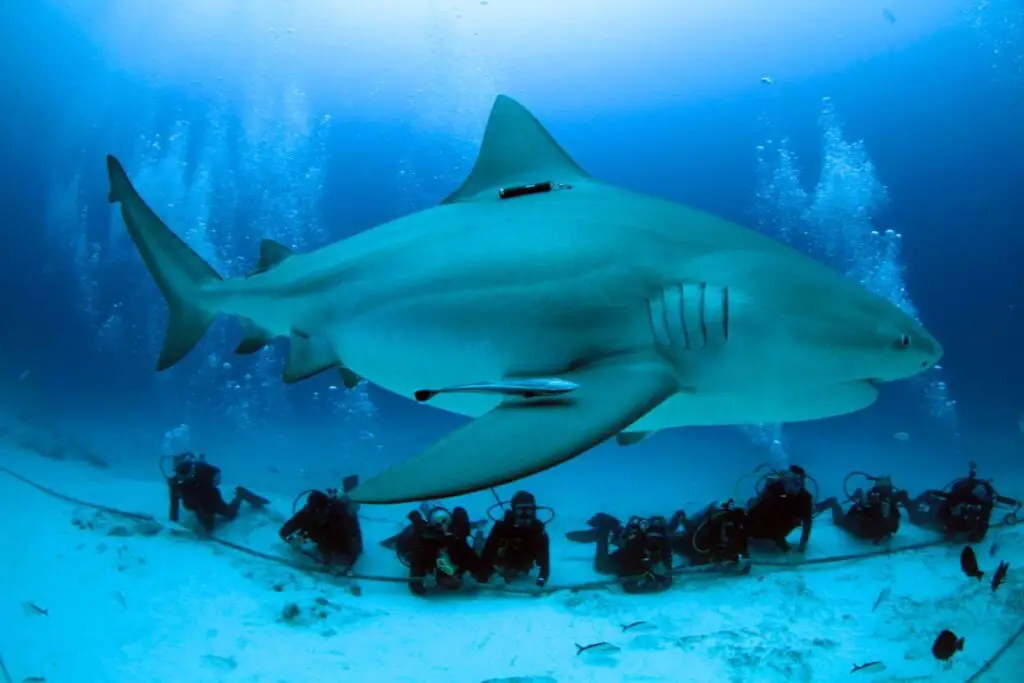
Ethical Considerations and Conservation Efforts
Most dive operators in Playa del Carmen follow ethical practices, such as avoiding the use of bait to attract sharks. Feeding bull sharks can alter their natural behavior and create dependencies, ultimately disrupting the ecosystem.
Responsible dive operations conduct non-baited dives, allowing divers to observe the sharks’ natural behavior without artificial influence. Some operators also contribute a portion of their earnings to conservation efforts, including initiatives that support marine life research and habitat protection.
The governmental conservation agency CONAMP charges a fee to divers visiting the protected area where the bull sharks can be seen. Certain dive operators include this conservation fee in the cost of bull shark dives, others do not.
This mandatory fee helps fund local efforts to protect the bull shark population and preserve their habitats. Supporting operators who engage in these conservation efforts can make a positive impact on the longevity and health of bull sharks in the region.
Not for profit organizations like Saving Our Sharks and Save Our Seas also help to preserve the species in this area. They have guides for responsible shark tourism and sustainable practices to minimize the risk of accidents and maximize the experience for divers. These guides help to develop awareness with our visitors about the importance of sharks in our marine ecosystem.
Read more: Saving the MesoAmerican Reef: 25 Tips for Reef-Safe Travel
Choosing a Responsible Dive Operator
Playa del Carmen has a variety of dive operators offering bull shark diving experiences, but it’s essential to select one that prioritizes safety and conservation.
Divers are encouraged to research operators carefully, looking for those with a commitment to ethical practices and environmentally sustainable operations. Good operators will enforce the rules around certification, ensure group sizes are small, and adhere to non-baiting policies.
Book your 2-Tank Bull Shark Adventure with Scuba Libre
Book your 1-Tank Extreme Bull Shark Dive with Scuba Libre
The Future of Bull Shark Diving in Playa del Carmen
As bull shark diving grows in popularity, there’s an increasing need to balance tourism with conservation. While bull shark encounters bring awareness and contribute to the local economy, unchecked tourism can put stress on the animals and their habitats. Choosing responsible operators and adhering to best practices as divers helps protect these magnificent animals for future generations.
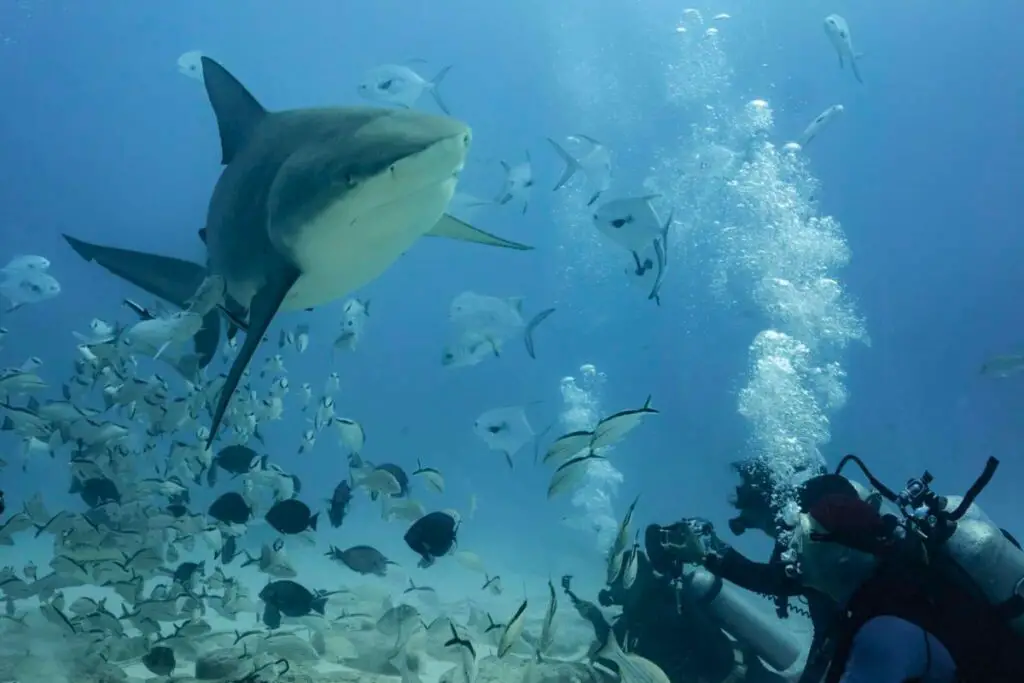
6 Ways Divers Can Help Protect Bull Sharks and Ensure Their Return to the Riviera Maya
Divers play a critical role in safeguarding bull sharks and their habitats. By practicing responsible diving and supporting conservation efforts, divers can help ensure that these magnificent creatures continue to thrive and return to the Riviera Maya season after season. Here are some impactful ways divers can contribute:
- Choose Ethical Dive Operators:
Supporting operators who prioritize conservation practices is one of the most effective ways divers can make a difference. Ethical operators conduct non-baited dives, maintain small group sizes, and follow environmental guidelines that respect the sharks’ natural behavior. Selecting operators that fund or engage in conservation efforts helps create a more sustainable diving industry and protects the sharks’ natural behaviors. - Respect the Marine Environment:
Respecting all marine life, not just the sharks, is crucial to maintaining healthy ecosystems. Divers should avoid touching or disturbing marine creatures, as well as refrain from collecting any “souvenirs” from the ocean. Even seemingly harmless interactions with marine life or coral can disrupt delicate ecosystems that bull sharks and other species rely on. - Participate in or Support Shark Conservation Programs:
Many organizations work to protect bull sharks and other shark species through research, habitat protection, and public education. Divers can contribute by donating, volunteering, or participating in citizen science projects, such as reporting sightings, behaviors, and environmental conditions. This data is invaluable to scientists studying shark populations and helps inform conservation policies. - Reduce Personal Impact on Oceans:
Simple lifestyle changes can also have a lasting impact on the health of our oceans. Using eco-friendly sunscreen, reducing plastic use, and properly disposing of waste reduces pollutants that threaten marine life. Divers who embrace sustainable living practices contribute to a healthier ocean environment for bull sharks and countless other species. - Advocate for Shark Conservation:
Divers who share their bull shark experiences can help raise awareness about the importance of shark conservation. By educating others about these animals and dispelling common myths, divers can shift public perception and encourage support for conservation initiatives. Social media, community events, and conversations with friends and family are all ways to spread awareness and inspire others to support shark-friendly practices. - Support Conservation Fees and Sustainable Tourism:
Many dive centers include conservation fees, which fund research, protection, and public education efforts. Supporting these fees and choosing responsible tourism options creates a positive impact on the local community and the marine life it depends on. Divers should see these contributions as investments in the continued presence of bull sharks along the Riviera Maya.
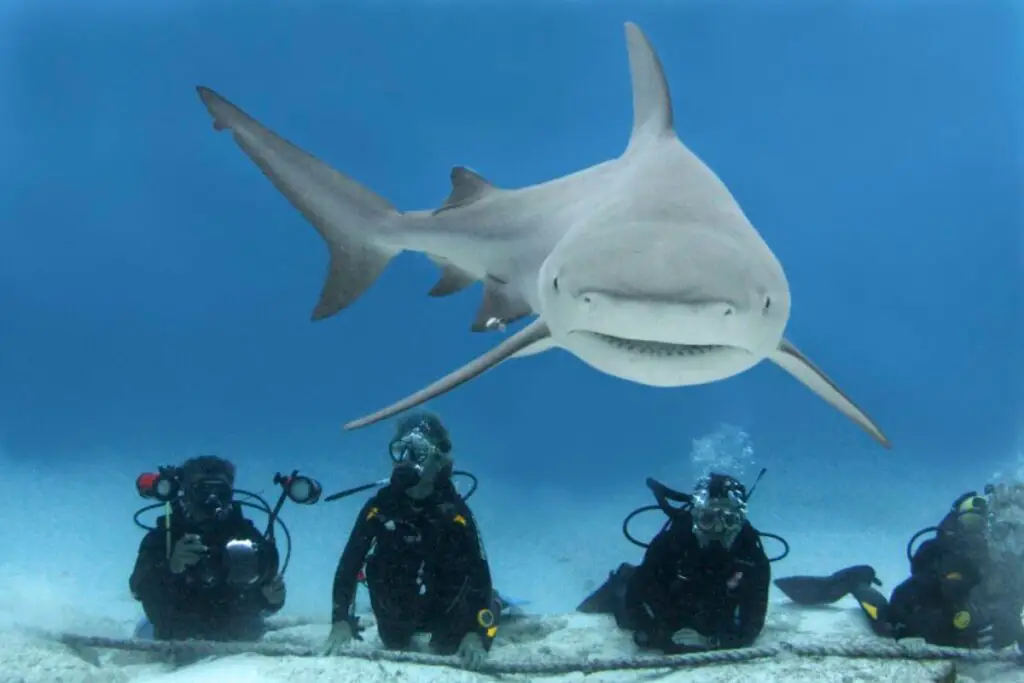
By taking these steps, divers not only enrich their own experiences but actively help protect bull sharks and the underwater ecosystems they inhabit. Through conscious choices and small contributions, divers can help secure a future where bull sharks return to the Riviera Maya year after year, continuing to inspire awe and respect among those who dive with them.
Read more: Saving the MesoAmerican Reef: 25 Tips for Reef-Safe Travel
Sources:
IFAW.org
WildPlaya.com
BarefootCozumel.com
DiveSSI.com
DivePointMexico.com
PhantomDivers.com


1 thought on “Bull Shark Season on the Riviera Maya”